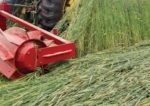Advertise Follow Us
Articles by Sarah Hill
No-tiller and crop consultant Jon Spreng, Perrysville, Ohio, says the biggest challenge to combining no-till and cover crops is finding a permanent weed control solution.
Read More
Minnesota Grower Strives to ‘Be the Solution’ with No-Till, Cover Crops
With 300 acres near Faribault, Minn., Tim Little has committed himself to focusing on conservation through reducing soil erosion.
Read More
Holistic Approach: Better Grazing with No-Till, Cover Crops
A South Dakota grower manages 10,000 acres to improve soil health, capture moisture and save money with fewer equipment passes and less labor.
Read More
No-Till, Cover Crops Improve Soil Health for Increased Profits
Achieving 300 bushel corn doesn’t necessarily mean maximum profits, says Illinois grower Jeff Martin.
Read More
Developing a Resilient No-Till System with Regenerative Ag
North Dakota grower Paul Overby utilizes no-till, crop diversity, livestock grazing and satellite imagery to withstand soil erosion and improve topsoil now and in the future.
Read More
Combining No-Till, Covers, Pheasants and Cattle
South Dakota grower Dennis Hoyle shares insights on how he’s been successful with no-till for more than 35 years and integrated cover crops and livestock into the system.
Read More
4 Ways to Optimize Cover Crop Benefits
Adding cover crops to your rotation can help improve soil health while offering flexibility to your no-till operation and improving the bottom line.
Read More
4 Takeaways from the 7th Annual National Strip-Tillage Conference
The virtual event assembled a diverse group of strip-till experts sharing experience-based advice on cover crop integration, custom strip-till economics and high-yielding corn tips.
Read More
Pros and Cons of 3 Cover Crop Seeding Methods
Three growers share their experiences with different cover crop seeding methods. Find out what worked for them and why they chose their preferred methods.
Read More
Most Cover Crops Seeded in Fall, Winter
The first annual Cover Crop Strategies Cover Crop Benchmark Study also finds 80% of growers prefer drills to seed cover crops.
Read More














